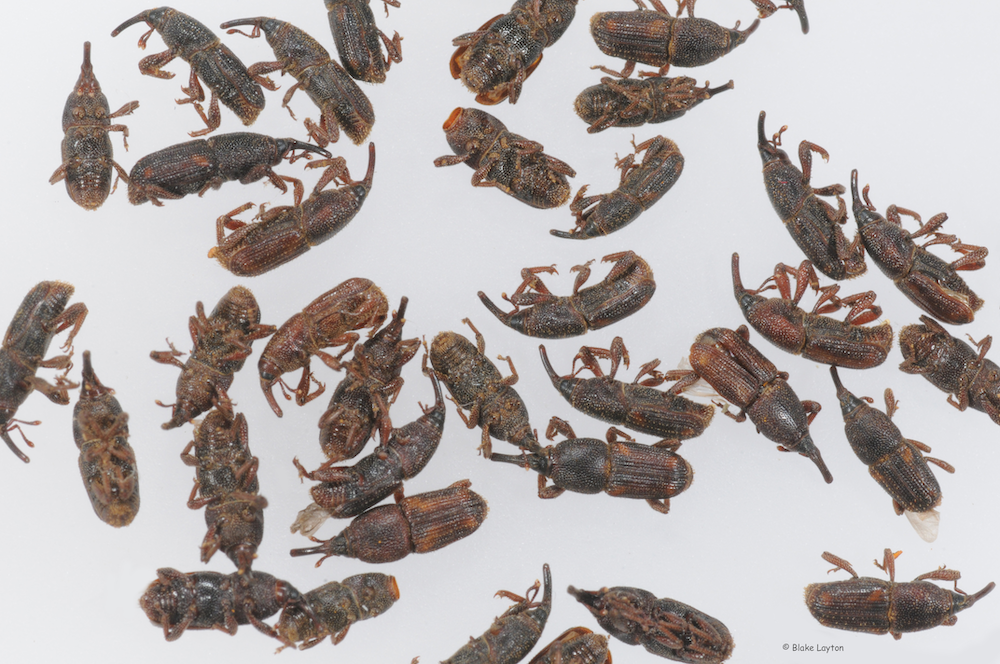Maize Weevils, Vol. 7, No. 1
Sitophilus zeamais
Order: Coleoptera
Family: Curculionidae
“We keep finding these little bugs in the kitchen. Sometimes they are on the counters or floors, sometimes on the windowsills. Where are they coming from and what can we do about them?”
Maize weevils are common stored grain pests that specialize in attacking whole dried grains. They use tiny mandibles on the ends of their snouts to chew into the seeds to feed and lay eggs, depositing only one egg in each seed. The legless grubs spend their lives feeding inside a single grain, in which they also pupate and from which they eventually emerge as 1/10- to 1/5-inch-long adults. Adults can fly and may move around a good bit as they search for mates and new food sources. It is these roaming adult weevils that keep appearing on the cabinets and windowsills, and their persistent reappearance means there are one or more weevil-infested food products in the kitchen or somewhere nearby.
As their name suggests, maize weevils love corn seeds, but they will also attack wheat, rice, buckwheat, sorghum, and similar grains. Adults emerging from corn tend to be larger than those emerging from wheat or rice because corn seed are bigger and provide more food for developing grubs. Maize weevils do not usually develop in flour or other finely ground grain products, but they will attack processed grain products formed into some type of shape—things like macaroni, cereal or dog treats—that adult weevils can chew into and lay eggs.
Maize weevil infestations begin when weevils gain access to stored grain products and lay their eggs. Infestations can also begin with adult weevils flying into fields to lay eggs after the grain has dried down and just before harvest. Such infestations will continue to develop in stored grains and controlling these and similar pests is an important task for grain farmers, grain buyers, and commercial food and feed processors. The longer grain is held in storage, the greater the potential for infestation and damage by these and other stored grain insects. This principal is also true on store shelves and in homes. The older a susceptible product is, the more likely it is to be heavily infested. Good exclusion and rotation practices are equally important in stores and homes.
Rice weevils, Sitophilus oryzae, and granary weevils, Sitophilus granarius, look so much like maize weevils that you need a microscope and identification key to tell the difference. But because control is similar for all three species, it is not usually important to do so.
Control: As with other stored food pests, exclusion and sanitation are the key methods of control. To prevent infestations, store susceptible items in insect-proof containers. To control active infestations, find and discard infested food products. Start by looking for whole grain items like corn, wheat, or rice, but keep in mind they can also breed in things like macaroni and cereals. Infestations can also occur outside the kitchen, in things like stored bird seed, decorative corn, bean bags, and similar situations. See pages 24-27 of Extension Publication 2443, Control Household Insect Pests, for more information.
Blake Layton, Extension Entomology Specialist, Mississippi State University Extension Service.
The information given here is for educational purposes only. Always read and follow current label directions. Specific commercial products are mentioned as examples only and reference to specific products or trade names is made with the understanding that no discrimination is intended to other products that may also be suitable and appropriately labeled.
Mississippi State University is an equal opportunity institution.
Bug’s Eye View is now on Facebook. Join the Bug's Eye View Facebook group here.


